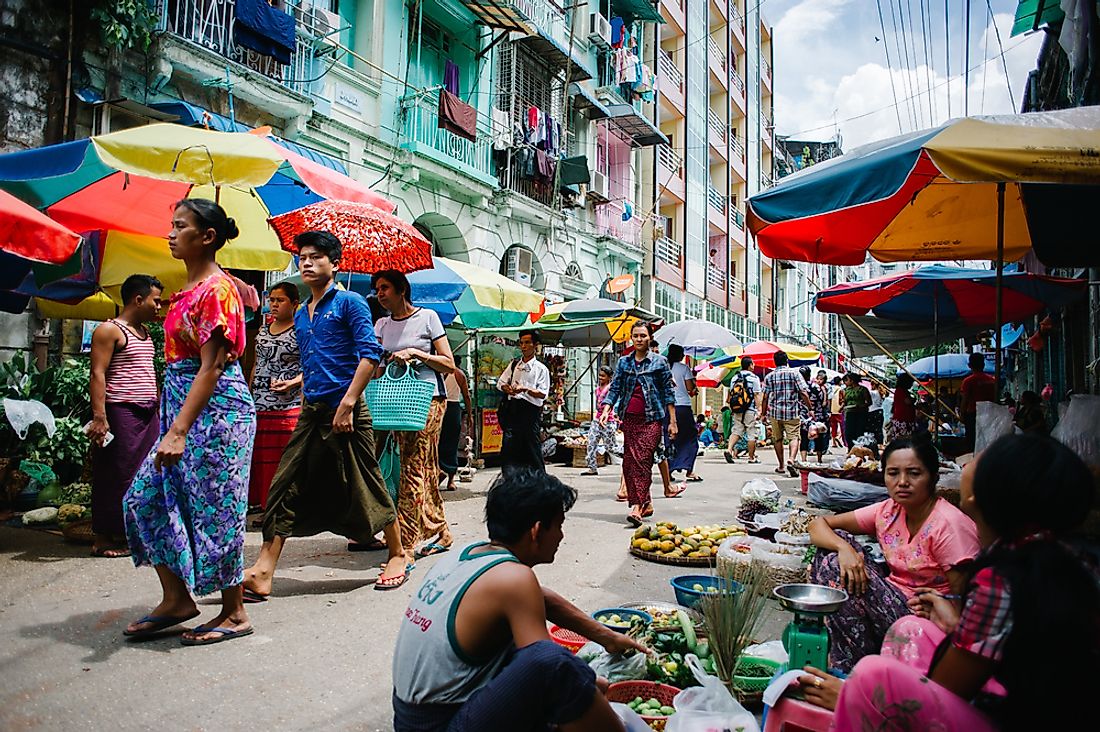Largest Ethnic Groups In Myanmar (Burma)

Myanmar, often referred to as Burma, is a nation in South East Asia. The country has an estimated population of 51.5 million people. Myanmar is a multi-ethnic country with at least 135 distinct ethnic groups recognized by the government. Bamar people are the predominant ethnic group at 68% of the Myanmar population. They dominate Myanmar's government and the military. The other ethnic minorities make up the remaining 32% of the population. Some of the ethnic minorities include Shan, Kayin, Rakhine, and Karen.
Bamar
The population of Bamar in the country is estimated to stand at 35,010,600 people. Their culture is a dominant culture in Myanmar. The term Burmanisation is used to refer to the influence of Burmese culture on the minority cultures. Bamar people have Tibetan and Chinese ancestry. They are mainly found in areas near the Irrawaddy and Sittang rivers. Rice and fish are their favorite diet. Puppetry is a common way of entertainment used in shows and festivals. Most Bamar community practice Theravada Buddhism. A popular ceremony whereby young boys turn into novice monks is celebrated annually by the Buddhist followers. Bamars speak Burmese, the official language of Myanmar.
Shan
The Shan people are estimated to comprise 4,663,700 members of the population in Myanmar today. They are said to have come from Yunnan province in China in the 10th Century. They occupy Shan State and are traditionally rice farmers. Shan people have been engaged in an armed struggle with the Myanmar government for decades. They fight for better treatment from the Burmese government. Members of Shan state have suffered inhuman treatment including forced labor, torture, rape, and confiscation of property perpetrated by the Myanmar government.
Karen
The Karen, or Kayin, people have a population in the country of close to 3,604,000. They are concentrated in the Southeastern region of Myanmar. Karen people mainly practice Buddhism and a minority group practice Christianity and Animism. Karen people have been involved in armed conflict with Myanmar government for over 60 years. They are victims of forced labor, government oppression, torture, and massacres. A ceasefire agreement between the Karen National Union and Myanmar government was signed in 2012, but it did not last.
Rakhine
The Rakhine, or Arakan, people are estimated to comprise 1,802,000 members of the nation's population. They occupy Rakhine state, a coastal region in Western Myanmar. Their culture has similarities with Burmese culture. The Arakanese language is closely linked to the Burmese language. The Rakhine people are predominantly Theravada Buddhists. Their culture has significant influence from the Indian culture especially the music and literature. Spiced rice and fish are their favorite meal in Rakhine homes. In recent years, Buddhist Rakhines have been in conflict with the Muslim Rohingyas who reside in Rakhine state.
Inter-Ethnic Relations
Despite that fact that Myanmar has for ages been housing a diverse collection of ethnic groups, the country has made little effort in encouraging and protecting its cultural diversity. Instead, Bamar Burmese culture is often imposed upon the smaller ethnic minorities. The constitution does not protect minority groups who have suffered oppression for many years. In 1947, an agreement to safeguard the rights of ethnic minorities was signed between the government and leaders of minority groups. However, the agreement was never implemented. As a result, ethnic armies emerged to fight for the minority groups. Clashes between the government and ethnic minorities led to a civil war that has plagued Myanmar for decades.
Largest Ethnic Groups In Myanmar (Burma)
| Rank | Ethnic Group | Estimated Population in Contemporary Myanmar (Burma) |
|---|---|---|
| 1 | Bamar | 35,010,652 |
| 2 | Shan | 4,663,763 |
| 3 | Karen | 3,604,038 |
| 4 | Rakhine | 1,802,019 |
| 5 | Chinese | 1,287,156 |
| 6 | Mon | 1,029,725 |
| Other Groups | 4,118,900 |







